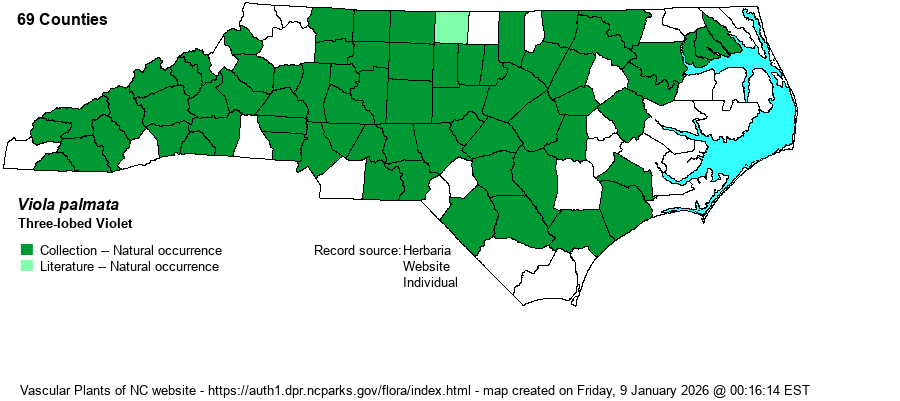| Author | L. | |
| Distribution | Essentially statewide, though apparently absent in the easternmost counties; no records east of Pasquotank, Martin, Pitt, and Jones counties. Quite a few SERNEC specimens need additional verification, as they might not be V. palmata upon further examination -- as several taxa have recently been pulled out from it.
This is an Eastern species, ranging from ME and WI, south to FL and LA. | |
| Abundance | Fairly common to common in the Mountains, Piedmont, and western/central Coastal Plain. Scarce in the eastern Coastal Plain, and likely absent in the far eastern counties. | |
| Habitat | This is a forest species, generally in upland habitats. It grow best in rich to mesic upland hardwood forests, but it can occur in dry forests, there more often over circumneutral soil. It can occur in barrens and glades, but only infrequently in floodplain forests, and if so, only in brownwater situations. |
| Phenology | Blooms from late March into May, and fruits shortly after flowering. | |
| Identification | This species is the most common of the several palmately-lobed violets of hardwood forests. This is an acaulescent, violet-blue-flowered species, and the leaves are of two types. Early leaves are always undivided, ovate to heart-shaped, with a cordate base. When flowering, there are several dissected leaves, typically with a wide middle lobe and several much smaller lateral lobes. The leaves tend to be moderately pubescent, at least on the undersides of the leaves and on the petioles. In V. edulis, which also has both undivided (early) leaves and divided (at flowering) leaves, the leaves are essentially glabrous, and the species is limited to blackwater wetlands (stream margins and swamps) of the Coastal Plain. V. septemloba, of Coastal Plain savannas, has the leaves glabrous as well. The lowermost lobe in V. palmata is directed parallel to the ground, whereas in V. septemloba the lowermost lobe is usually directed toward the ground. V. subsinuata has all of its leaves divided, including the earliest ones. It grows in the same habitats and range as does V. palmata, so be careful with your identification of upland violets with divided leaves. | |
| Taxonomic Comments | Weakley (2022) lists three varieties, as many references do, or at least did; RAB (1968) listed three varieties, though their var. sororia is now part of the large V. sororia as named in Weakley (2018). Most of their var. palmata and var. triloba are part of the current V. palmata, but note that the current V. edulis and V. subsinuata were formerly included within these two varieties. The website editors are holding off on adding varieties to the website owing to the unsettled nature of Viola taxonomy, particulalrly as one of the varieties of this species is undescribed.
General note on Viola: In 2009-10 B.A. Sorrie (website map editor) went through the whole collection at NCU, annotating all specimens against those verified by experts in the genus. The range maps in RAB (1968) have been changed accordingly. More recently, Harvey Ballard and colleagues are in the process of revising all Eastern and Southeastern Viola, and have annotated all specimens at NCU in July 2024. They recognize additional species not in RAB or in previous editions of Weakley et al.; we will follow updated editions of Weakley et al. in recognizing them. Species range maps have been adjusted to account for identification changes. | |
| Other Common Name(s) | Trilobed Violet, Early Blue Violet (used on the website for V. subsinuata), Wood Violet | |
| State Rank | [S5] | |
| Global Rank | G5 | |
| State Status | | |
| US Status | | |
| USACE-agcp | FACU link |
| USACE-emp | FACU link |

